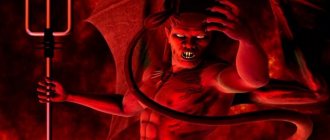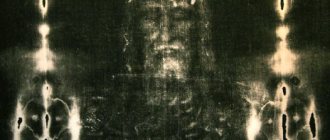What is exorcism in simple words
Before defining what exorcism is, it is worth telling why it arose. All religions recognize the existence of evil spirits - demons and demons that penetrate the human body and force him to commit godless acts. Demons instill in a person hatred, anger, despondency, thoughts of suicide, etc. There are demons that cause writhing, tics, convulsive seizures, and the desire to blaspheme.
The girl was possessed by the devil
They learned to cast out the devil with the help of spells and prayers back in pre-Christian times. But the heyday of such rituals occurred in the Middle Ages. At this time, it was customary in religion to talk about the devil’s machinations and the possibility of the devil introducing himself into the human body. Lines from the Bible and other religious books were read out, where such incidents were told in vivid colors. Impressionable religious people literally absorbed information, which led to the development of obsession.
The possessed man believed that the devil had possessed him and was forcing him to do and say unacceptable things. The most unpleasant thing was that the devil could capture many people at the same time, causing real epidemics. Epidemics spread especially often in women's monasteries; nuns became “infected” from each other and became insane.
If they tried to treat such an epidemic en masse using prayers, then this led to its even greater spread. This contributed to the emergence of special rituals of individual exorcism, called exorcism.
Orthodox prayer for exorcism
If the previous prayer is universal and suitable for almost any person, regardless of his religion, then this one is Christian Orthodox.
It is believed that even a simple “Our Father” or “Creed” helps protect a person from the machinations of evil spirits. This is why daily prayers are practiced in almost every religion.
Here is a typical Orthodox prayer, which was used in rituals to expel demons and other evil spirits from a person:
Of course, the possessed person must be a baptized Christian; only in this case is it permissible to apply this prayer to him. The same applies to the exorcist who will perform the ceremony.
Signs of Devil Possession
According to the description of eyewitnesses, the possessed are disgusted with the Holy Gifts, the Holy Trinity, and the Virgin Mary. They are afraid of holy water, spit, call names, grimace, without feeling fear or regret. Periodically, they begin to have attacks of severe anger with convulsions, lasting several hours in a row. At the same time, the possessed person becomes unusually strong. An obsessed woman can cope with a strong man and even more than one.
The Church will help cast out demons
Sometimes the possessed lose consciousness, their pulse is almost not palpable and their breathing is not caught. After some time, they may regain consciousness and behave as if nothing had happened.
Epidemics of obsession
Epidemics of obsession literally took over the Middle Ages. Thus, in the Madrid monastery, the epidemic began with the appearance of obsession in one of the nuns. She developed convulsive seizures and foamed at the mouth. She moaned, barked, cursed the Lord and shouted that the unclean spirit of Peregrino had possessed her.
The obsession quickly spread to other nuns. They suffered for days, believing that Peregrino's friends had possessed them. The influence of prayer did not help and then the Inquisition exiled the possessed to remote monasteries, which made it possible to stop the epidemic of possession.
There were cases when priests were accused of sending devilish spells. Their fate was unenviable: some were burned at the stake, despite confessing to all their sins after torture in the Inquisition; others, who did not confess, suffered the same fate.
"Reprimand those who reprimand"
Psychiatrist priest Grigory Grigoriev emphasizes that before the revolution, clergy were recommended to carry out scoldings individually, “in order to cut off those suffering from hysteria, who in the church were called cliques.” They, according to him, often attract attention at church services with sharp cries and other demonstrative actions, which are perceived by believers as demonic possession, although they are not. The demoniac, according to the priest, is distinguished by fear of church sacraments, holy relics, holy water and miraculous icons.
Professor Alexander Dvorkin has an extremely negative attitude towards the current practice of scolding. According to him, he agrees with the opinion of Patriarch Alexy II, who many years ago at one diocesan meeting said that one should “reprimand those who scold.”
“Reprimands are a completely unconventional phenomenon that degenerates into some kind of hysterical, gloomy and extremely unpleasant shows. Of course, as an Orthodox person, I understand that demonic possession undoubtedly happens. Christ cast out demons from possessed people, the saints also did this in His name,” noted the head of RACIRS.
Professor Dvorkin suggests turning to the lives of saints, from which it is clear: if some confessor or saint cast out demons, then this was always done exclusively individually - not in public, not en masse. “Also, this was never a long process and did not turn into lengthy dialogues with demons, collections of which were sold in our church shops quite recently,” he noted.
]]>
]]>
Icon "St. Marina of Antioch slaying the demon." 1857 Lazaros. Athens.Kept in the Byzantine Museum (Greece)
Exorcism ritual
At first, during epidemics of possession, clergy tried to influence the crowd by reading prayers. But this often had the opposite effect: the “infection” spread to new masses of people. The only way to stop the epidemic was to quickly isolate the possessed and perform individual exorcism rites on them.
Preparation for the ceremony
The rite of exorcism is still carried out today in accordance with religious principles. It can only be performed by a specially trained clergyman. His own faith, conviction in the correctness of his actions and the ability to convey this conviction to others are of great importance. The personality of the priest performing the ceremony is of great importance. Thus, there is information that Pope John Paul II removed signs of possession from a young girl with one touch of his hand and a blessing.
Removal of obsession in ancient times
Nowadays, the rite of exorcism is necessarily preceded by a consultation with a psychiatrist, since the symptoms of possession may be similar to the symptoms of mental illness. It is impossible to cure a mentally ill person (for example, with schizophrenia) through exorcism.
In addition to the exorcist, one more person must be present during the ritual - an observer. It is better if the witness is a physically strong person, since those possessed at certain times can exhibit superhuman strength. Both the priest and the observer must undergo purification in the form of fasting and confession before performing the ritual.
Carrying out the ritual
To conduct the ceremony, the patient is placed in a separate isolated room with a minimum amount of furniture.
He is fixed in bed and the exorcist priest begins the ritual, which includes:
- establishing the name of demons and the way of their penetration into the body of the possessed;
- reading prayers;
- sprinkling the possessed with blessed water;
- applying Holy Scripture to it.
The evil spirit is trying to escape
The evil spirit often willingly calls its name and begins to mock the exorcist, insult him and the Lord, spit, etc. But the exorcist insists that the demon must leave the body. When the ritual is performed correctly by an experienced clergyman, the evil spirit goes away and the possessed person experiences relief.
It is a fact that famous exorcists warned: it is not just necessary to cast out demons and cleanse the soul. It is important to place the Lord in your soul. Only in this case will the demons not be able to return again.
Detection of demonic possession
Obsession is not obvious in everyday life. A person in ordinary circumstances may simply appear somewhat strange, unpleasant, or aggressive. The role of litmus is played by the usual attributes of divine services, perceived positively by churchgoers - blessed water, a crucifix, the sign of the cross, liturgy or any prayer.
Observing demonic possession is very difficult. The possessed person behaves disgracefully: he makes faces, screams in strange voices, imitates the sounds made by animals, lies on the floor and commits other outrages. Sometimes opinions are expressed that such scenes are played out deliberately, and the entire ritual is a performance designed to create a reputation for the exorcist priest as a fighter against evil spirits. It cannot be ruled out that there are cases of falsification, but the author of these lines himself witnessed the terrible behavior of people whom he could not suspect of deliberate lies. They would simply be ashamed of the very possibility of looking so disgusting.
Exorcism and the Church
All religions have exorcism rituals. The most famous are, of course, Catholic rites. Exorcists are trained at Catholic universities, where they study not only religious subjects, but also the basics of psychiatry. The ritual of exorcism in Catholicism is strictly regulated. Interest in such rituals not only has not dried up, but, on the contrary, has been increasing in recent years.
Demons steal your soul in your sleep
In Orthodoxy, possession is known as demon possession and hysteria. The ritual of reading prayers was performed on such people. This is usually done by a priest who has the experience and mental strength to conduct such rituals.
Islam, Judaism, Hinduism, and Buddhism also have similar rituals. The ritual of expelling evil spirits in Buddhism is interesting. First, the Buddhist monk tries to bring the spirit out of the body peacefully, persuading it to leave the body. If this cannot be done, then they resort to special rituals with mantra-spells. The evil spirit that has left the body is placed in a closed box and burned.
Church dualism
The opinions of Orthodox priests regarding the possibility and usefulness of carrying out the procedure of exorcism are divided. Most church representatives do not consider it possible to get rid of a dark entity through a one-time scolding. In general, the Orthodox attitude to the rite of exorcism is expressed in the words of Gogol’s character: “He does not need to look for the devil who has him behind him.” Having cast out one demon, you can accept a whole legion of new evil spirits, if there is a nutrient medium for it.
The Church names two effective means of combating obsession: fasting and prayer. The following facts speak in favor of refusing proofreading:
- This rite never belonged to church sacraments, such as baptism, confession, communion or confirmation (of seven in total).
- The patriarchs of the Russian Orthodox Church have never blessed anyone for reprimanding.
- The ritual as such really exists, but it cannot be applied to several, much less many, people at the same time.
So, the first opinion has been expressed, but there is another. Exorcism is practiced at the Trinity-Sergius Lavra and several Orthodox monasteries outside Russia. The ritual is in demand by the flock; believers travel thousands of kilometers to participate in it.
5 Zodiac Signs Who Get Stressed and Panic Too Easily
How to eat grapefruit correctly so as not to feel bitterness
Handsome, you can’t take your eyes off: Dmitry Pevtsov showed what he looked like 37 years ago
Totalitarianism is alien to the Russian Orthodox Church, and therefore cases of a direct ban on reprimanding are extremely rare. The clergy only points out the high degree of responsibility that the elders assign to themselves when they undertake to cast out demons.
Exorcism and psychiatry
Psychiatry believes that a properly performed exorcism ritual really helps, but provided that the person does not have a mental illness.
For example, with a disease such as schizophrenia, a person hears voices in his head. These voices can tell, command, and even punish a person in various ways. For a believer, these voices may “belong” to demons. It is impossible to rid such a person of demons using religious rituals.
But most of the possessed are healthy, but very suggestible people. Most often, these are women with hysterical personality traits, prone to demonstrative behavior and easily suggestible. In the past, such people were influenced by religion and were most afraid of evil spirits.
If such fertile soil was superimposed on the bright sermons of the clergy about demons and demons that take over the body and soul, they acquired the properties of suggestion in reality, the person developed corresponding beliefs, illusions and hallucinations, which then turned into persistent delirium. That is, hysterical neurosis develops.
Where and how much are demons cast out?
According to MDA professor Osipov, today people who sometimes take on the task of reprimanding are not those who received this special gift thanks to a holy life. “People sometimes take it upon themselves to reprimand out of arrogance, vanity, and greed, about which we find more than enough evidence,” states Osipov.
“It is clear that reprimands bring popularity to the priests who conduct them. People begin to come to them, this brings in massive amounts of money, increases income, so in certain dioceses the hierarchy supports such events, or at least does not interfere with their holding,” notes Dvorkin, in turn.
Judging by messages on the Internet, trips to the village of Chikhachevo, Ivanovo region, to Schema-Archimandrite Ioannikius (Efimenko) are quite popular among believers. Hieromonk Vladimir (Gusev) is also known in the city of Livny, Oryol region. In Ukraine, they go to lectures at the Pochaev Lavra or the Elias Monastery in Odessa.
On the Internet you can find lists of dozens more places throughout Russia where reprimands take place. Therefore, on numerous websites of pilgrimage services there are even special tours to famous exorcists. Pilgrimages are held mainly on weekends; it is recommended to register for them in advance, due to the large number of applicants.
As a rule, on the websites of pilgrimage centers, a donation for a trip is mentioned, but the “donation amount” cannot be seen - it is announced when communicating by phone. It may include, for example, only the round trip. There are also all-inclusive packages, which provide, in addition to travel, housing, food and necessities. For example, a trip from Moscow to Livny will cost about 6 thousand rubles, including two prayer services “For the Sick” (as they call it at the pilgrimage center) and unction.
To be fair, it is worth noting that you can attend the lectures without making a donation.
Suggestion in reality - how it happens
The mechanism of suggestions in reality was well described by the outstanding Russian psychiatrist V.M. Bekhterev in the book “Suggestion and its role in public life.” According to modern concepts, the human psyche consists of:
- consciousness – it critically evaluates any incoming information;
- subconscious or unconscious, accepting any information without critical evaluation; It’s just that consciousness, like an older brother, does not allow unverified information to penetrate into the subconscious.
Suggestion by a demon occurs in reality
In order to enter information into the subconscious, you need to distract the conscious mind. This is exactly what happened during long sermons and prayers: consciousness was dulled and frightening information about demonic entities was introduced at the subconscious level. Of course, all this was done unconsciously, but it gave rise to the development of obsession.
The rite of exorcism is carried out according to the same principle: the consciousness is lulled to sleep by a long reading of the prayer, and then the command to exorcise is sharply introduced into the subconscious. Consolidating the session in the form of an appeal to the Lord by the healed person is also legitimate from the point of view of psychiatry: the removal from the psychic sphere of such information that is significant for a person creates a void in which, according to the definition of the clergy, new seven demons can settle (for example, the demon of despondency, anger, stinginess, etc. .).
Exorcism interesting facts
Many myths have been created around exorcism, which are sometimes impossible to distinguish from reality. Here are some of them:
- The first cases of expelling evil spirits were described in Sumerian texts 2000 BC. Ancient healers exorcised evil spirits using spells.
- The ritual of expelling evil spirits did not always take place peacefully. For example: the Jewish story Josephus describes a ritual in the form of a possessed person taking a poisonous drink;
- in our time in Romania, an exorcism session, accompanied by tying to a cross, prolonged fasting and thirst, led to the death of a young nun.
- artist Salvador Dali - he suffered from schizophrenia and in 1947 conducted an exorcism session; in this case it was difficult to hope for a positive effect;
- in Catholicism - Father Gabriel Amorth (Vatican);
Why is exorcism dangerous?
A properly conducted exorcism session by an experienced, trained clergyman will not cause harm. In most cases, it will contribute to the recovery or relief of the possessed person’s condition. Damage will occur if:
- the ritual is performed with a mentally ill person suffering from schizophrenia, epilepsy, etc. – the reaction of such patients is unpredictable, they can suffer significant harm;
- the ritual is carried out by a non-specialist, which causes a deepening of neurosis;
- in addition to prayers, physical methods of influence are used to force demons to leave the human body: beating, starvation, etc.; There were many such examples not only in the Middle Ages, but also in our time: in 2010 in Britain, a teenager was killed during a ritual independently carried out by relatives to expel demons with water.
Possession Fictions and Their Tragic Consequences
There were especially many fictions related to obsession in the Middle Ages. This caused horror among believers and prepared fertile ground for the outbreak of psychic epidemics of obsession. Most of them ended tragically.
Possessed child turns into a possessed child
An example of how self-hypnosis and fiction turns into persistent conviction can be the case of the development of demon possession in two French Ursuline nuns in 1610. They developed unusual movements and some other signs, which led them to be recognized as possessed. Apparently, one of them suffered from mental illness, while the second was very suggestible.
A mentally ill nun claimed she was under a spell from a local priest. The second nun confirmed this. Despite the fact that this priest had an excellent reputation, the Inquisition took care of him. As a result, under torture, he admitted that he had intercourse with the devil and that he infected thousands of women with poisonous devil's breath. Despite self-incrimination and admission of guilt, the priest was burned at the stake. And the possessed nuns were isolated and had exorcism sessions, which led to the recovery of one of them.
When it comes to what exorcism is and whether it has a place in modern life, religion and psychiatry are unanimous in their opinion: if you have faith in God and the existence of demons, a correctly performed exorcism ritual will undoubtedly be beneficial. But only a specially trained clergyman should conduct it.
Vice, illness or obsession?
The presence of an inner dark essence is different in nature from other vices common to many people. A reprimand will not help overcome smoking, drunkenness, passion for gambling, and especially drug addiction. The same applies to spiritual and physical illnesses that require medical treatment or personal volitional efforts of the sinner. Demon possession is not an excuse for adultery, anger, envy or greed. The very desire to transfer one’s own vicious aspirations to the evil one is a dangerous temptation.
A Russian nutritionist explains how to replace sausage in sandwiches
Not yet Novoseltsev: what young Myagkov looked like in his first film (photo)
A Siberian woman married a Thai man, and now she doesn’t know how to divorce him










